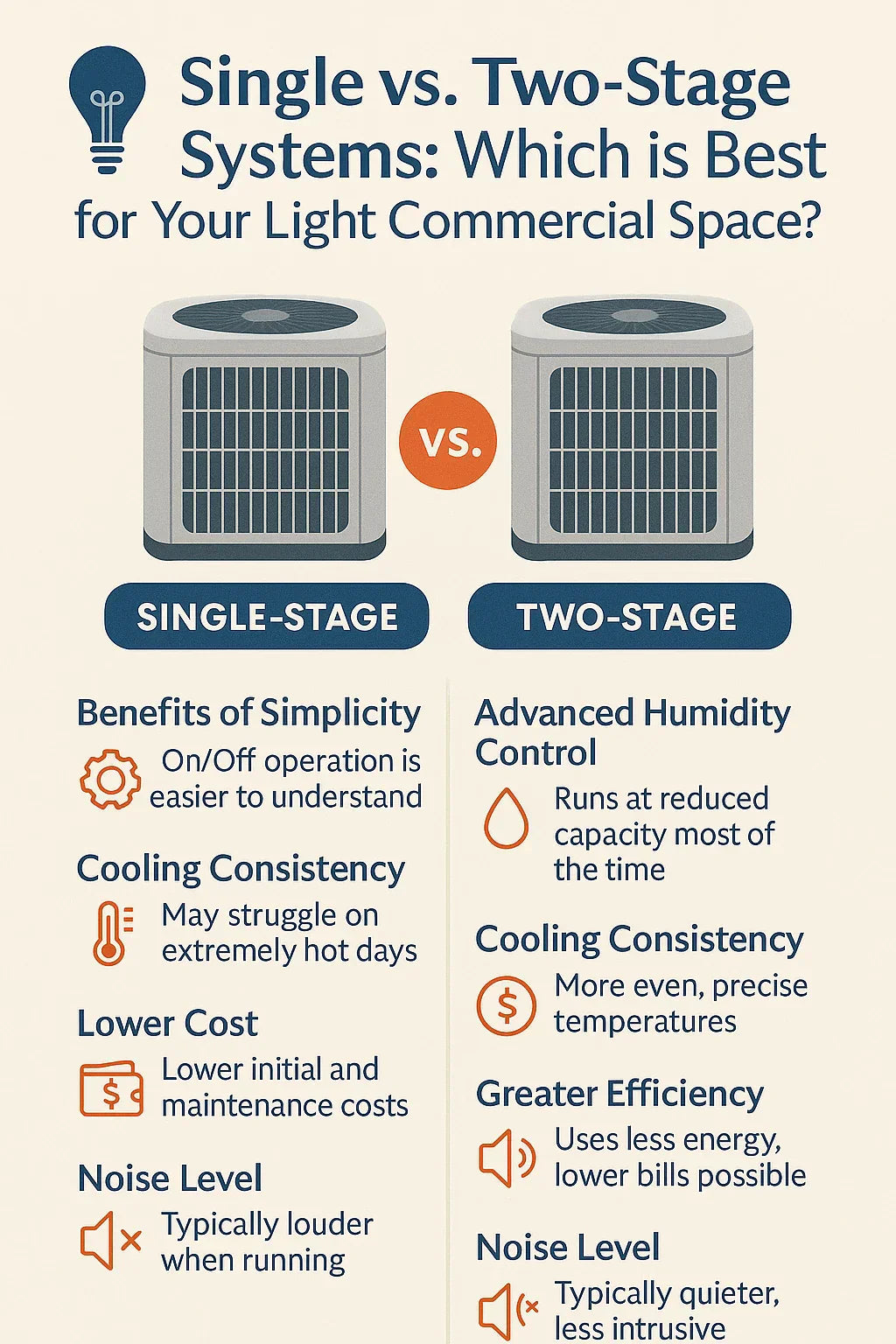When considering a 5-ton Daikin light commercial AC system, you may wonder whether a single-stage or two-stage system is better for your business, church, retail store, or large home.
This guide covers:
-
The difference between single-stage and two-stage systems.
-
Pros and cons of each for light commercial settings.
-
How staging affects comfort and humidity control.
-
Energy usage and cost comparisons.
-
Maintenance and long-term considerations.
-
Choosing the right system for your operational goals.
⚙️ What’s the Difference Between Single-Stage and Two-Stage Systems?
Single-Stage AC:
-
Operates at one speed: 100% capacity when cooling is needed.
-
Shuts off when the set temperature is reached.
-
Simpler operation, fewer moving parts.
Two-Stage AC:
-
Has two operating levels:
-
Low stage (~60–70% capacity) for mild cooling needs.
-
High stage (100% capacity) for peak demand.
-
-
Runs longer cycles at lower speeds to maintain temperature.
Learn the technical differences in detail from Energy Star’s HVAC efficiency page.
🌡️ Comfort and Humidity Control
Single-Stage Comfort:
✅ Quickly cools the space. ✅ May lead to temperature swings due to frequent cycling. ✅ Less effective at humidity removal in humid climates.
Two-Stage Comfort:
✅ Maintains more consistent temperatures. ✅ Longer runtime at lower speeds allows better humidity control. ✅ Feels more comfortable in hot, humid regions where moisture removal is critical.
In light commercial environments (churches, salons, offices), two-stage systems often provide better occupant comfort, especially when humidity impacts productivity or equipment performance.
Read about humidity control and comfort from ASHRAE.
💡 Energy Efficiency and Operating Costs
Single-Stage Systems:
-
Lower upfront cost.
-
Short, high-power cycles can consume more electricity during peak demand.
-
Simpler system with fewer components.
Two-Stage Systems:
-
Higher upfront cost (~10–20% more).
-
Longer, lower-speed operation reduces energy spikes.
-
Potentially lower monthly utility bills, especially in climates requiring extended cooling.
-
Helps reduce demand charges in commercial utility rate structures.
Calculate potential energy savings with a two-stage system using this Department of Energy HVAC calculator.
🛠️ Maintenance and System Longevity
Single-Stage:
✅ Fewer components and simpler design. ✅ Easier and less expensive to repair. ✅ Frequent cycling may increase wear on components.
Two-Stage:
✅ Lower cycling reduces wear on compressors and fans. ✅ May extend system lifespan due to smoother operation. ✅ Maintenance costs may be slightly higher due to additional components.
Routine maintenance is critical for either system to maintain efficiency and avoid costly repairs.
Explore best maintenance practices at HVAC.com.
🏢 Which Is Best for Your Light Commercial Space?
Choose Single-Stage If:
✅ You have a tighter budget and need lower upfront costs. ✅ Your facility is in a dry, mild climate with low humidity. ✅ You require quick cooling with less concern about temperature swings.
Choose Two-Stage If:
✅ Your facility is in a hot, humid climate. ✅ You want consistent comfort for customers and staff. ✅ Humidity control is important for equipment or product storage. ✅ You plan to stay long-term and want lower energy bills and extended system life.
🎯 Key Takeaways
✅ Single-stage systems offer simplicity and lower upfront costs but may increase operating expenses in humid or hot climates. ✅ Two-stage systems provide consistent comfort, better humidity control, and potential energy savings, making them ideal for many light commercial applications. ✅ Consider your climate, budget, and operational goals before deciding.
In the next topic we will know more about: Maintaining Your Daikin 5-Ton AC System for Long-Term Performance







